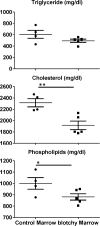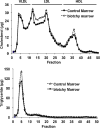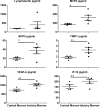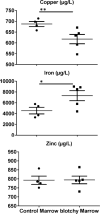Counteract of bone marrow of blotchy mice against the increases of plasma copper levels induced by high-fat diets in LDLR-/- mice
- PMID: 26004886
- PMCID: PMC5675067
- DOI: 10.1016/j.jtemb.2015.02.003
Counteract of bone marrow of blotchy mice against the increases of plasma copper levels induced by high-fat diets in LDLR-/- mice
Abstract
Background: Bone marrow of blotchy mouse (blotchy marrow) reflects the function of transmembrane domain and relevant intramembrane sites of ATP7A in myeloid cells. By chronic infusion of angiotensin II, we previously found that blotchy marrow plays a minor role in regulating plasma copper. Moreover, the recipients of blotchy marrow presented a moderate reduction of plasma lipids and inflammatory mediator production. Little is known about whether these changes are a specific response to angiotensin II or reveal a more general role of ATP7A.
Objective and design: We investigated if blotchy marrow reduces plasma lipids and inflammatory mediators induced by high-fat diets. To test this hypothesis, blotchy and control marrows were reconstituted to the recipient mice (irradiated male LDLR-/- mice), followed by high-fat-diet feeding for 4 months. At the end points, plasma metals (copper, zinc and iron), lipid profiling (cholesterol, triglyceride, phospholipids and lipoprotein) and six inflammatory mediators (lymphotacin, MCP3, MCP5, TIMP1, VEGF-A and IP-10) were measured. Parallel experiments were performed using male LDLR-/- mice fed either high-fat diets or chow diets for 4 months.
Results: In addition to hyperlipidemia and low-grade inflammation, high-fat diets selectively increased plasma copper concentration compared to chow diets in LDLR-/- mice. After high-fat-diet feeding, the recipients with blotchy marrow showed a decrease in plasma copper (p < 0.01) and an increase in plasma iron (p < 0.05). The recipients with blotchy marrow also presented decreases in cholesterol (p < 0.01) and phospholipids (p < 0.05) in plasma. Surprisingly, plasma levels of MCP3 (p < 0.05), MCP5 (p < 0.05), TIMP1 (p < 0.01), VEGF-A (p < 0.01) and IP-10 (p < 0.01) were significantly increased in the recipients with blotchy marrow compared to controls; the increased levels of MCP3, MCP5 and TIMP1 were more than 50%.
Conclusion: Our studies showed that blotchy marrow counteracts the increased copper levels induced by high-fat diets, indicating that circulating myeloid cells can regulate blood copper levels via ATP7A. Moreover, transplantation of blotchy marrow followed by high-fat diets leads to a decrease in lipid profile and an increase in inflammatory mediator production. Overall, blotchy marrow mediates divergent responses to angiotensin II and high-fat diets in vivo.
Keywords: ATP7A; Bone marrow; Copper; Inflammation; Lipid metabolism.
Copyright © 2015 Elsevier GmbH. All rights reserved.
Conflict of interest statement
There was no conflict of interest in the manuscript.
Figures




Similar articles
-
Bone marrow from blotchy mice is dispensable to regulate blood copper and aortic pathologies but required for inflammatory mediator production in LDLR-deficient mice during chronic angiotensin II infusion.Ann Vasc Surg. 2015 Feb;29(2):328-40. doi: 10.1016/j.avsg.2014.10.006. Epub 2014 Oct 29. Ann Vasc Surg. 2015. PMID: 25449986 Free PMC article.
-
Production of LPS-induced inflammatory mediators in murine peritoneal macrophages: neocuproine as a broad inhibitor and ATP7A as a selective regulator.Biometals. 2013 Jun;26(3):415-25. doi: 10.1007/s10534-013-9624-4. Epub 2013 Apr 19. Biometals. 2013. PMID: 23604539
-
Insulin-degrading enzyme deficiency in bone marrow cells increases atherosclerosis in LDL receptor-deficient mice.Cardiovasc Pathol. 2013 Nov-Dec;22(6):458-64. doi: 10.1016/j.carpath.2013.03.006. Epub 2013 May 17. Cardiovasc Pathol. 2013. PMID: 23684818
-
Reduced femoral bone mass in both diet-induced and genetic hyperlipidemia mice.Bone. 2016 Dec;93:104-112. doi: 10.1016/j.bone.2016.09.016. Epub 2016 Sep 23. Bone. 2016. PMID: 27669658
-
Effect of macrophage-derived apolipoprotein E on hyperlipidemia and atherosclerosis of LDLR-deficient mice.Biochem Biophys Res Commun. 2004 Apr 23;317(1):223-9. doi: 10.1016/j.bbrc.2004.03.037. Biochem Biophys Res Commun. 2004. PMID: 15047172
Cited by
-
Lipid-related metabolism during zebrafish embryogenesis under unbalanced copper homeostasis.Fish Physiol Biochem. 2022 Dec;48(6):1571-1586. doi: 10.1007/s10695-022-01127-8. Epub 2022 Sep 26. Fish Physiol Biochem. 2022. PMID: 36161547
-
Mechanism of Astragalus membranaceus Alleviating Acquired Hyperlipidemia Induced by High-Fat Diet through Regulating Lipid Metabolism.Nutrients. 2022 Feb 23;14(5):954. doi: 10.3390/nu14050954. Nutrients. 2022. PMID: 35267929 Free PMC article.
References
-
- Mercer JF, Grimes A, Ambrosini L, Lockhart P, Paynter JA, Dierick H, et al. Mutations in the murine homologue of the Menkes gene in dappled and blotchy mice. Nat Genet. 1994;6(4):374–8. - PubMed
Publication types
MeSH terms
Substances
Grants and funding
LinkOut - more resources
Full Text Sources
Other Literature Sources
Research Materials
Miscellaneous

